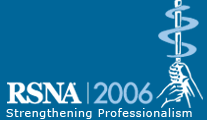
Abstract Archives of the RSNA, 2006
Scott Robert Akers MD, PhD, Presenter: Nothing to Disclose
Kevin Marin Baskin MD, Abstract Co-Author: Nothing to Disclose
Anne Marie Cahill MBBCh, Abstract Co-Author: Nothing to Disclose
Clara Lombara MD, Abstract Co-Author: Nothing to Disclose
Leonardo Gonzales MD, Abstract Co-Author: Nothing to Disclose
Richard Bruce Towbin MD, Abstract Co-Author: Nothing to Disclose
This study defines and measures the relationships of central venous structures in infants, and extends to this population a system for unequivocal description of central venous access device (CVAD) location based on structures visible on chest radiographs.
Multi-planar images and scout chest radiographs from 30 CT studies in infants < 2 years of age were recalled to a 3-D workstation. The limits of SVC, carina, apparent right heart border (RHB), and right mainstem bronchus (RMB) were marked on the scout image. Corresponding vertebral levels were noted, and measurements made with electronic calipers. For studies (n=7) that included a CVAD, catheter tip position relative to the spine and to the cavoatrial junction (CAJ) was recorded. The angle between the terminal catheter segment and the long axis of the SVC was measured.
The CAJ was 1.75 ± 0.36 vertebral body units below the carina (VBC) with a 95% confidence interval 1.12-2.36 VBC, independent of patient age, weight, body surface area or gender (all P>0.05). For the 7 patients who had a CVAD, the catheter tip was located from 0.5-4.5 VBC. The tip angle (range: 0-33 degrees) was strongly related to tip distance in either direction from a point approximately 2.5 VBC (R = 0.90). SVC length was 2.4 ± 0.5 cm. The CAJ was anterior to the T5-T6 intervertebral disc ± 0.9 vertebral body units. The RHB was most frequently associated with the right atrial appendage, but was 1.0 ± 0.7 cm superior to the CAJ. The RMB was 1.1 ± 0.5 cm superior to the CAJ, and the carina was 1.5 ± 0.5 cm superior to the CAJ.
Understanding SVC anatomy is essential for correct interpretation of thoracic images and in evaluation of CVAD. The CAJ is located more inferiorly than commonly believed, and is not accurately estimated by common imaging landmarks. A point just less than 2 VBC accurately estimates the CAJ. Catheter tip position can and should be reliably described in VBC, using the thoracic spine as an internal ruler.
A point just less than 2 vertebral bodies below the carina on a CXR reliably estimates the cavoatrial junction in infants. This provides an unequivocal approach to describing catheter tip location.
Akers, S,
Baskin, K,
Cahill, A,
Lombara, C,
Gonzales, L,
Towbin, R,
The Cavoatrial Junction in the Infant: Correlation between CT and Plain Film Landmarks. Radiological Society of North America 2006 Scientific Assembly and Annual Meeting, November 26 - December 1, 2006 ,Chicago IL.
http://archive.rsna.org/2006/4438400.html

